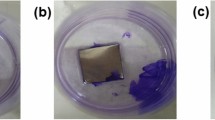Abstract
Metal foreign bodies in the eye are commonly removed utilizing a surgical approach through the vitreous cavity, which requires a maintained ocular pressure by infusion of replacement “irrigation solution”, i.e., electrolyte. However, when in contact with aerated electrolyte, if the fragment comprises galvanized steel, the component metals can act as a bimetallic zinc/steel cell, thereby electrochemically generating injurious amounts of hydroxyl ion OH−. The effect on this electrochemical reaction of the compositions of the irrigation solutions in use, and of their analogues, has thus been investigated, to seek the least damaging. The inter-metallic current relates directly to the rate of the injurious reaction, hence amperometry has been the principal probe employed in our study. Establishing reproducible conditions of contact between electrolyte and the steel–zinc combination forms a major focus of the study, which is to attain amperometric reproducibility in the comparison of the electrolytes. Geometry-sensitive directed injection of test solution into a cell with pre-fixed separate steel and Zn electrodes achieved the desiderata. Besides potentiometry and amperometry, pH and buffering by the various test solutions, and the effects of surfactants, were also examined. Free-radical intermediates in the oxygen processes are further injurious suspects. Anaerobic conditions that would preclude both intermediates and OH− are unfortunately damaging to the structures of the eye, so alternative surgical procedures are needed. Anti-corrosion aspects are considered.
Similar content being viewed by others
Notes
The first hyaluronan biomedical product… is approved for use in eye surgery (i.e., corneal transplantation, cataract surgery, glaucoma surgery and surgery to repair retinal detachment) [and for]… other ophthalmic surgery.
See foot note 1.
References
Steel DHW, Rosseinsky DR, James CR (1998) Acute retinal toxicity caused by the bimetallic electrochemical action of a galvanised steel intraocular foreign body. Retina—J Retin Vit Dis 18:77–79
Jones D (1996) Principles and prevention of corrosion, 2nd edn. Prentice Hall, Upper Saddle River. ISBN 0-13-359993-0
Averbeck M, Gebhardt CA, Voigt S, Beilharz S, Anderegg U, Termeer CC (2007) Differential regulation of hyaluronan metabolism in the epidermal and dermal compartments of human skin by UVB irradiation. J Invest Dermatol 127:687–697
Stern R, Asari AA, Sugahara KN (2006) Hyaluronan fragments: an information-rich system. Eur J Cell Biol 8:699–715
http://www.bausch.com/en_US/ecp/age/amviscplus.aspx. Accessed February 17, 2009
http://en.wikipedia.org/wiki/Hyaluronan. Accessed February 17, 2009
Barnhill JG, Fye CL, Williams DW, Reda DJ, Harris CL, Clegg DO (2006) Chondroitin product selection for the glucosamine/chondroitin arthritis intervention trial. J Am Pharm Assoc (Washington, DC) 46(1):14–24
Roberts GAF (1992) Chitin chemistry. The Macmillan Press, Basingstoke
Chiang MT, Yao HT, Chen HC (2000) Effect of dietary chitosans with different viscosity on plasma lipids and lipid peroxidation. Biosci Biotechnol Biochem 64(5):965–971
Rosseinsky DR, Soutar AM (1993) Electro-chemical and reflectance study of the conversion of zinc oxide by hexacyanoferrate(II) in offset lithography. Part II: zinc electrochemistry in sodium dihydrogen phosphate together with other minor components. J Appl Electrochem 23:187–190
King DA Cambridge University: private communication
Sharma RG, Mishra YC, Verma Gl, Lal K (1983) A clinical evaluation of oxygen and carbon dioxide values and pH in the human aqueous humour in normal and cataractous eyes. Indian J Ophthalmol 31:525–527
Ullrich V, Kissner R (2006) Redox signaling: biochemistry at its best. J Inorg Biochem 100:2079–2086
McNaught AD, Wilkinson A (1997) IUPAC compendium of chemical technology 69:1274–1277
Kersey TL, Rosseinsky DR, Freegard T, James CR (in preparation) (Provisional title): Surgical avoidance of acute retinal toxicity associated with galvanized (zinc/steel) intraocular foreign bodies in reaction with vitrectomy solutions
Acknowledgements
We thank Dr. Sam Tapsell for obtaining a direct splinter analysis that established its galvanized-steel composition, and Mrs. Ellen Green for extensive laboratory assistance throughout the amperometry.
Author information
Authors and Affiliations
Corresponding author
Rights and permissions
About this article
Cite this article
Rosseinsky, D.R., Winlove, C.P., Strawbridge, S.M. et al. Comparative amperometry on ocular-surgery electrolytes in eye-splinter trauma from galvanized-steel electrochemistry. J Appl Electrochem 39, 1559–1564 (2009). https://doi.org/10.1007/s10800-009-9839-9
Received:
Accepted:
Published:
Issue Date:
DOI: https://doi.org/10.1007/s10800-009-9839-9




